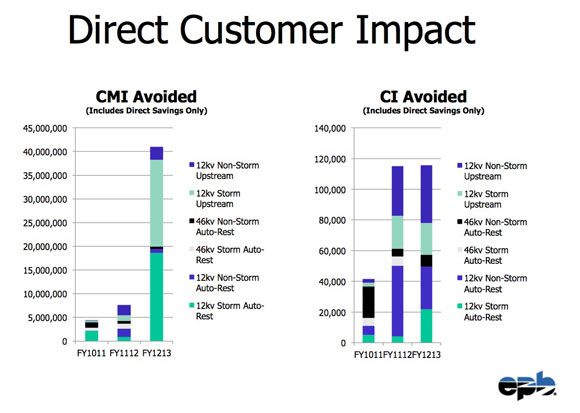The Chattanooga Times Free Press fired the head of its Free Press editorial page, Drew Johnson, for running a headline that was not approved for publication last week.
The headline "Take your jobs plan and shove it, Mr. President: Your policies have harmed Chattanooga enough” was published the day President Obama visited the city. It criticized the administration’s job creation policy and also the stimulus funds that were a part of EPB Chattanooga’s decade-long $552 million grid improvement plan.
The editorial claimed the $111.6 million in stimulus funds from the American Recovery and Reinvestment Act (ARRA) of 2009 went to a “Gig to Nowhere, a $552 million socialist-style experiment in government-owned Internet, cable and phone services orchestrated by EPB -- Chattanooga’s government-owned electric monopoly.” Johnson goes on to call the investment “an absolute bust.”
The editorial failed to mention that ARRA was not just a jobs program; it was also focused on improving American infrastructure. In the utility industry, there were projects that would stimulate short-term job creation (installation, IT setup, and integration of backend systems), but many of the grants were directed toward underlying infrastructure improvement and grid modernization.
Grid modernization projects require a smaller number of professional workers improve the grid itself (compared to, say, building a new highway) while allowing for larger-scale testing of new technologies that can make the generation, transmission and delivery of electric power more reliable, efficient and cleaner. The bulk of Chattanooga’s deployment fit into the latter category. There were four key investments that were accelerated by EPB’s ARRA grant:
- Deployment of the system-wide fiber optic network
- Reliability upgrades, including a fleet of 1,170 S&C IntelliRupters for fault location, isolation and service restoration (FLISR)
- Improvements in EPB’s enterprise infrastructure (including an OSI distribution management system, SCADA integrated with the in-progress CGI Group outage management system with Mobile Workforce Management System, load and consumption forecasting software from OATI and Bell Labs, respectively, and meter data management software)
- Deployment of roughly 170,000 advanced meters with Tantalus fiber-to-the-home communications
Is the Grid Better?
Besides the issue of job creation, another point of Johnson's was that “there has been little improvement in the quality of EPB’s electric service,” a claim that is not supported by reliability figures that EPB has reported.
EPB Chattanooga has found that under blue-sky conditions in 2013 -- the first year in which EPB had full system automation -- the utility decreased its System Average Interruption Duration Index (SAIDI) figure by 21 percent from the previous year. The System Average Interruption Frequency Index (SAIFI) decreased by more than 45 percent compared to 2012.

Source: EPB Chattanooga/GTM Research
Even for particular storms, EPB has been able to quantify savings due to the technological improvements, something that many other utilities struggle to do. The automation and sensing capabilities enabled by intelligent equipment and strong communications capabilities allowed EPB to more accurately determine location of outages and perform better initial damage assessment, saving hundreds of truck rolls and improving field crew efficiency.
Looking at a few of the major events over the past thirteen months, the improvement in service is considerable. In just one storm, for instance, EPB Chattanooga saved $1.4 million.
In some cases, such as the storm in July 2012, the automated grid was able to restore service to more than half of those affected.

Additionally, EPB has been able to leverage advanced sensing capabilities to diagnose and work with commercial and industrial customers to address power quality concerns improving both EPB’s quality of service and reducing interruptions in sensitive manufacturing.
How Much Does It Cost?
The editorial also claimed that when EPB’s first bond payment comes due this fall, customer rates will invariably go up because EPB won’t otherwise be able to manage the debt.
It is true that capital-intensive improvements have an upfront cost, but the important question is whether the upfront costs are outweighed by the long-term benefits. In the case of EPB, as with most utilities, this is yet to fully be seen. But if Chattanooga can survive a major storm while other regions in Tennessee lose power in the future, the answer may start to become clearer.
There are also many ways that EPB’s upgraded system can help save money besides just quicker outage restoration. The utility’s new data stream will allow it to right-size transformers and enable conservation voltage reduction to save energy that then doesn’t have to be purchased in the first place.
The editor for the Free Press was not fired, however, for questioning EPB’s business plan for grid improvement or the president’s job creation figures. He was terminated for not having his headline approved.
That fact is important, because whether the readers of the Free Press agree with editor or not (and there were plenty of readers who commented on both sides of the debate), there is clearly a misunderstanding between much of the general public and the utility industry as to what grid improvement looks like and what that is worth.
In the U.S., the electrical grid is relatively reliable, far better than India, if not as reliable as South Korea. For the most part, when we flip a switch, something turns on.
EPB Chattanooga has been one of the utilities that has been able to quantify savings from its investments, and it continues to do so. But even though EPB is one of the utilities that has real data on what its investment is doing, the message had not trickled down to this particular newspaper editor, and probably not to many others.
For utilities of all sizes, the challenge is not deploying FLISR or improving SAIDI; it’s explaining to its customers why investments in the grid matter, and what they are getting out of it, especially if it is going to mean higher costs.



